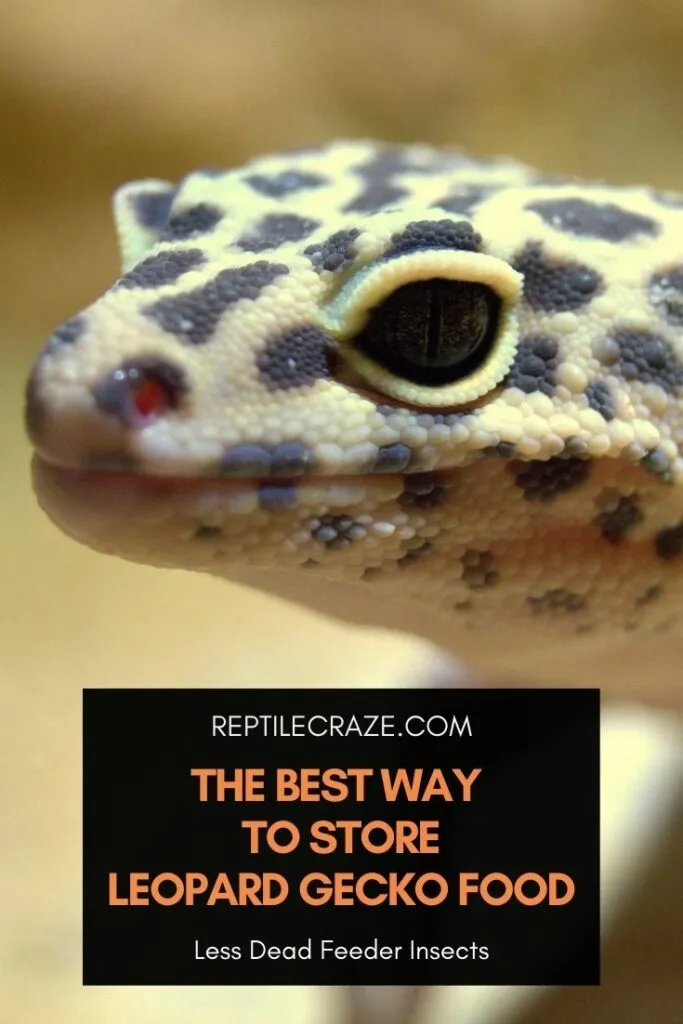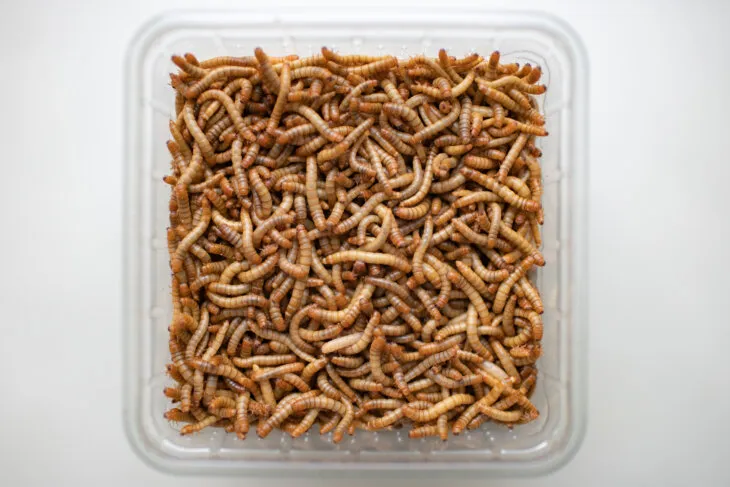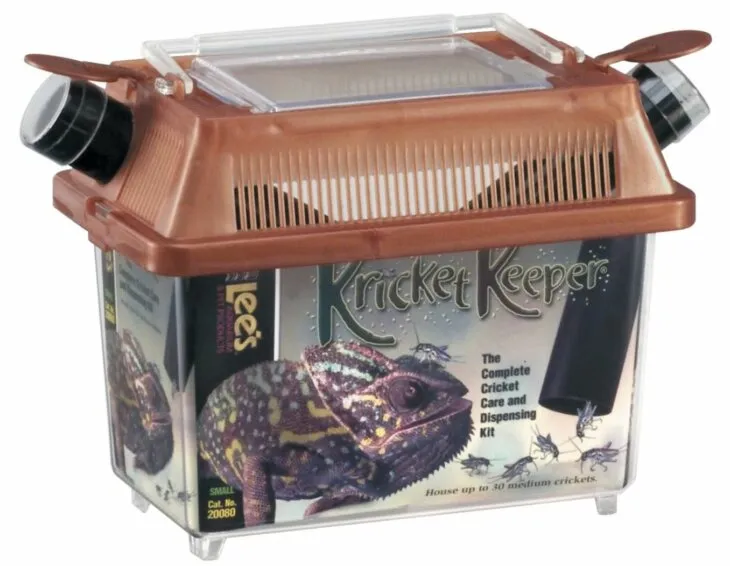
Knowing how to store the feeder insects for your Leopard Gecko (Eublepharis macularius) diet is essential. Good storage practice means that they will last longer, be better value for money, and give the greatest nutritional value to your Leopard Gecko. So, what is the best way to store Leopard Gecko
Feeder insects need to be provided with appropriate housing,
That’s the quick answer, but as the methods of storage for each insect differ so much, there is a lot more to learn. Let’s discover the best way to store some of the most popular feeder insects for Leopard Geckos.
Table of Contents
How To Store Crickets

If you store them well, crickets can survive for 8-10 weeks. Their full-grown adult size is around 1 inch in length. So, if you have an adult Leopard Gecko who can eat large crickets, it is worth keeping your crickets alive for as long as possible.
Housing Crickets
Crickets can be kept all together in an enclosure that has a ventilated lid. A simple box like the one pictured below is ideal. These are available in all pet shops. However, if your crickets are small, you may need to add extra-fine mesh to the ventilated lid to prevent escapees.
The size of the crickets enclosure should be 1 gallon in volume, per 100 crickets kept inside. There’s no such thing as too big a
The crickets will need some shelter. The easiest and most effective material is cardboard egg trays. Sometimes, crickets are delivered with this type of material also.
Simply tear the trays up a bit to provide an array of hiding places and some litter substrate.
Every week, be sure to thoroughly clean and dry your cricket habitat. This will help prevent the growth of bacteria and fungi, which could be harmful to your Leopard Gecko.
Dead crickets release toxins that smell bad and can kill the live crickets, so it is very important to remove them.
Crickets need to live in a warm environment. You can’t keep them in the fridge. 75°F to 85°F is appropriate. If your room isn’t this warm, you might want to supply a heat lamp to keep your crickets healthy.
To encourage your crickets to grow, turn up the heat to between 80°F and 90°F.
Tip: Wanna know how much it costs to feed leopard geckos (per month)? Read our article here!
Feeding Crickets
Crickets will need to be provided with
Crickets need a water source to drink from. Unfortunately, they can easily drown in a dish of water. To prevent this, give your crickets a bug gel such as Fluker’s Cricket Quencher.
The gel is fortified with calcium, so it will help improve their calcium to phosphorus ratio.
Crickets love to eat a wide range of fruits and vegetables. However, there are some that are harmful to your Leopard Gecko, such as avocado. To play on the safe side, you can simply provide some apple slices, kale, potato slices, etc.
The easiest way to feed crickets is to provide some commercially available
Gut-loading Crickets
Also, Calcium Food for Crickets (like this one) is important for gut-loading your crickets before giving them to your Leopard Gecko. (We still recommend to also feed fresh veggies or fruits)
The cricket
Gut loading feeder insects is essential for the health of your Leopard Gecko.
If you do not gut load your crickets for 48 hours before giving them to your Leopard Gecko, then your pet will ingest nutrient-poor
Eventually, this would lead to illness and possibly death.
How To Store Mealworms

There are two main ways to store mealworms. You can store them cold, to prevent their development into pupa and eventually into the darkling beetle. Or, you can keep them warm, which will encourage them to grow and eventually to pupate and transform.
Housing Mealworms
Mealworms should be kept in wide, shallow containers. As long as the container is about 1 inch above the mealworms’ substrate, they can’t get out.
Choose a container that is easy to clean, such as plastic or glass. (The box we recommend above is also okay for mealworms)
After cleaning and drying the mealworm
It is both a bedding and
Spread the mealworms out so that they can burrow into the bedding. A larger container is always preferable. The bedding should be changed approximately once per week.
Keeping Mealworms Warm And Lively
To keep mealworms at their natural temperature, they should have an environment of 70F. At this temperature, they will eat a lot and grow rapidly. They will be useful for about 3 weeks before pupating.
Keeping Mealworms Cold And Dormant
If you house mealworms in the fridge at 45-50F, you can cause them to become dormant. This will delay their transformation to pupa and eventually darkling beetles.
Refrigerated mealworms can remain useful for feeding to your Leopard Gecko for 6-10 weeks.
Before putting mealworms in the fridge, it is important to feed them. When they are cold and become dormant, they will not eat. If they haven’t had a good meal beforehand, they may starve.
Take them out of the fridge for 24 hours each week. Feed them, then place them back in the fridge. Before feeding the mealworms to your Leopard Gecko, remove them from the fridge for 24 hours and gut load them.
Feeding and Gut Loading Mealworms
Mealworms need
Once per day you should cut some raw potatoes and carrots into small chunks. Sprinkle these over the mealworm bedding. The mealworms may bury them. Each day, clear away old pieces and give them new ones.
Also, you can use commercially available
It is calcium-enriched, so will help correct the calcium to phosphorus ratio of mealworms which is good for the health of your Leopard Gecko.
Mealworms also need a water source, but can easily drown in water. Each day, provide a fresh small dish of bug gel. This is a safe way to hydrate the mealworms and also enrich them with calcium.
How To Store Other Popular Feeder Insects
Wax worms
Can be stored in the fridge in the container they arrive in. No need to feed or water. Aren’t usually gut loaded.
Dubia roaches
Store in a smooth-sided box with a ventilated lid. Give cardboard egg trays for shelter. Store at 70-90°F. Provide bug gel for hydration, as well as slices of potato and carrot for
Black soldier fly larvae
Store them in the cup that they arrived in at room temperature. No need to feed or water.
Silkworms
Feed them mulberry leaves, silkworm
Hornworms
Keep them in the cup they arrive in, which usually has
However, don’t leave them in there for too long, or at cooler temperatures, or they will die.
- Enchi Ball Python: A Unique and Stunning Morph of Python regius - March 27, 2025
- Emerald Tree Monitor: The Enigmatic Green Guardian of the Rainforest - March 26, 2025
- The Egyptian Cobra (Naja haje): A Fascinating Serpent - March 25, 2025

